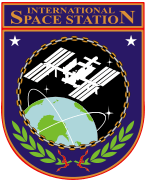Automated Transfer Vehicle
 | |
|---|---|
| Description | |
| Role: | Supply the International Space Station with propellant, water, air, payload and experiments. |
| Crew: | None, but human-rated.[1] |
| Dimensions | |
| Height: | 10.3 m (34 ft) |
| Diameter: | 4.5 m (15 ft)[2] |
| Launch Payload: | 7,667 kg (16,903 lb)[3] |
| Return Payload: | None |
| Mass at launch: | 20,750 kg[2] |
| Pressurized Volume: | 48 m3[4] |
| Electrical Energy | |
| Source: | 4 solar panel wings of 4 panels each and 40Ah rechargeable batteries |
| Size: | total span 22.3 m |
| Generated Power: | 3,800 W |
| On-board engines | |
| Main engine: | 4 × 490N, Aerojet (GenCorp) Model R-4D-11 |
| Thrusters : | 28 × 220N for attitude control & braking, Airbus Lampoldshausen |
| Performance | |
| Endurance: | Docked with the ISS for six months |
| Apogee: | 400 km |
| Perigee: | 300 km |
| Inclination: | 51.6 degrees |
| Launch | |
| Location: | CNES's Guiana Space Centre, Kourou in French Guiana |
| Site: | ELA-3 |
| Booster: | Ariane 5 |
The Automated Transfer Vehicle, originally Ariane Transfer Vehicle or ATV, was an expendable cargo spacecraft developed by the European Space Agency (ESA).[5] ATVs supplied the International Space Station (ISS) with propellant, water, air, payloads, and experiments. ATVs also reboosted the station into a higher orbit.
Five ATVs, Jules Verne, Johannes Kepler, Edoardo Amaldi, Albert Einstein, and Georges Lemaître were launched, with the first in March 2008. On 2 April 2012 the ESA announced that the ATV program would end after the fifth ATV was launched in 2014.[6]
Further developments of the ATV have been studied by the European Space Agency and Airbus Defence and Space.[7][8][9] ESA member states decided in 2012 that the ATV would be adapted to serve as the service module of the NASA Orion spacecraft. In January 2013, the ESA and NASA announced the combined Orion and ATV derived service module.[10]
Design
The ATV was designed to complement the Progress spacecraft, having three times its capacity. Like the Progress, it carried both bulk liquids and relatively fragile freight which is stored in a cargo hold kept in a pressurized shirt-sleeve environment so that astronauts could access it without putting on a spacesuit. The ATV pressurized cargo section was based on the Italian-built Multi-Purpose Logistics Module (MPLM), which was a Shuttle-carried "space barge" transporting equipment to and from the Station. Unlike the MPLM, the ATV used the Progress docking mechanism.
The ATV docking system consists of two videometers and two telegoniometers built by Sodern, a subsidiary of Airbus.[11] Data processing for the rendezvous docking maneuver and emergency abort systems have been designed and manufactured by CRISA. Additional monitoring data and redundancy is provided by the Kurs[12][13] automatic docking system, also used by Soyuz and Progress spacecraft. Visual imagery is provided by a camera on the Zvezda ISS module.
The ATV, like the Progress, also serves as a container for the station's waste. Each ATV weighs 20.7 tonnes at launch and has a cargo capacity of 8 tonnes:[3]
- 1,500 kilograms (3,300 lb) to 5,500 kilograms (12,100 lb) of dry cargo (re-supply goods, scientific payload, etc.),
- Up to 840 kilograms (1,850 lb) of water,
- Up to 100 kilograms (220 lb) of gas (nitrogen, oxygen, air), with up to two gases per flight,
- Up to 4,700 kilograms (10,400 lb) of propellant for the re-boost maneuver and refueling the station. The ATV propellant used for re-boost (monomethylhydrazine fuel and N2O4 oxidizer) is of a different type from the payload refueling propellant (UDMH fuel and N2O4 oxidizer).
Development
The prime contractor for the ATV is Airbus Defence and Space, leading a consortium of many sub-contractors. Development was started in Les Mureaux, France and moved to Bremen, Germany, as the project moved from its development to production stage of the four initial units starts. In order to facilitate the relationship between the contractor and ESA an integrated ESA team at the Les Mureaux site has been established for the duration of the development.
The first ATV arrived at the ESA spaceport in Kourou, French Guiana on 31 July 2007 after a nearly two week journey from Rotterdam harbour and was launched on 9 March 2008.[14] The Jules Verne was the first ATV to be launched.[15] Airbus Defence and Space builds the ATVs in its facility in Bremen. Contracts and accords were signed in 2004 for four more ATVs, which should be launched about once every two years, bringing the total order, including Jules-Verne, to five.
To this end, RSC Energia has signed a €40 million contract with one of the main subcontractors of Airbus Defence and Space, the Italian company Alenia Spazio (now Thales Alenia Space), to supply the Russian Docking System, refuelling system, and Russian Equipment Control System.[16] Within the Airbus Defence and Space led project, Thales Alenia Space is in charge of the pressurized cargo carrier of the ATV. These pressurized cargo carriers are produced in Turin, Italy.
In addition to its use by ESA and Russia, the ATV was in the running to service NASA under the Commercial Orbital Transportation Services program. Under the proposal, a joint venture between EADS and Boeing, an ATV would be launched from Cape Canaveral, Florida, using a Delta IV rocket. Ultimately, it was not awarded a contract.
The development cost of the ATV was approximately €1.35 billion,[17] and each ATV spacecraft costs about US$300 million, not including launch costs.[18]
Use

ATVs are intended to be launched every 17 months in order to resupply the International Space Station.[19] They use GPS and a star tracker to automatically rendezvous with the Space Station. At a distance of 249 m, the ATV computers use videometer and telegoniometer data for final approach and docking manoeuvres. The actual docking to Zvezda is fully automatic. If there are any last-minute problems, a pre-programmed sequence of anti-collision manoeuvres, fully independent of the main navigation system, can be activated by the flight engineers aboard the station.
With the ATV docked, the station crew enters the cargo section and removes the payload. The ATV's liquid tanks are connected to the station's plumbing and discharge their contents. The station crew manually releases air components directly into the ISS's atmosphere. For up to six months, the ATV, mostly in dormant mode, remains attached to the ISS with the hatch remaining open. The crew then steadily fills the cargo section with the station's waste. At intervals of 10 to 45 days, the ATV's thrusters are used to boost the station's altitude.
Once its mission is accomplished, the ATV, filled with up to 6.5 tonnes of waste, separates. Its thrusters move the spacecraft out of orbit (de-orbit) and place it on a steep flight path to perform a controlled destructive re-entry high above the Pacific Ocean.
-

Johannes Kepler Automated Transfer Vehicle's launch as seen from the ISS
-
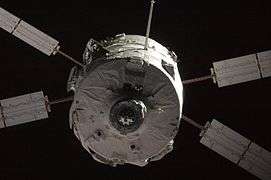
Jules Verne Automated Transfer Vehicle approaches the International Space Station
-

ATV interior with Expedition 17 crewmembers
-
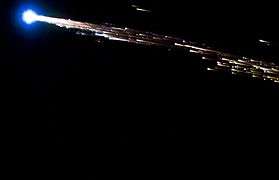
Jules Verne as it re-enters Earth's atmosphere in a controlled burn-up after undocking from ISS
Missions
| Designation | Name | Launch date | ISS docking date | Deorbit date | Sources |
|---|---|---|---|---|---|
| ATV-1 | Jules Verne | 9 March 2008 | 3 April 2008 | 29 September 2008 | [20][21] |
| ATV-2 | Johannes Kepler | 16 February 2011 | 24 February 2011 | 21 June 2011 | [22][23] |
| ATV-3 | Edoardo Amaldi | 23 March 2012 | 28 March 2012 | 4 October 2012 | [24][25][26][27] |
| ATV-4 | Albert Einstein | 5 June 2013 | 15 June 2013 | 2 November 2013 | [28][29][30][31] |
| ATV-5 | Georges Lemaître | 29 July 2014 | 12 August 2014 | 15 February 2015 | [32][33] |
On 2 April 2012, ESA announced that the ATV program would end after the fifth ATV is launched in 2014. No additional ATVs will be funded.[6]
Jules Verne
The first flight of the ATV was delayed many times before its launch on 9 March 2008. It was named Jules Verne, in memory of the first science fiction writer of modern times. The Jules Verne carried two of the author's original handwritten manuscripts, to be received by the ISS crew as symbolic tokens of the success of the first flight.[34]
The craft was launched into a 300-kilometre (190 mi) orbit atop an Ariane 5 from the equatorial ELA-3 launch site at the Guiana Space Centre. The ATV separated from the Ariane rocket and after weeks of tests and orbit adjustments successfully docked in the International Space Station at 14:45 UTC on 3 April 2008.
In the early morning hours of 29 September 2008, the Jules Verne burnt up on entering the atmosphere above an uninhabited section of the Pacific Ocean, southwest of Tahiti.
Johannes Kepler
Launched on 17 February 2011,[35] Johannes Kepler was at the time the heaviest payload ever launched by the European Space Agency[36] and carried 7000 kg of cargo to the ISS.[37] The first launch attempt on 15 February 2011 had been halted during the final countdown at four minutes from lift off due to an erroneous signal from one of the rocket's fuel tanks.[38]
On 29 April 2011, the engines of the ATV were used to rotate the ISS in order for a Russian Progress supply craft to dock with the station.[39]
Due to the delayed launch of STS-134 the mission of Johannes Kepler was extended, and it undocked from the ISS on 20 June 2011. It deorbited a day later on 21 June 2011.[40]
Edoardo Amaldi
The third ATV vehicle arrived in French Guiana in late August 2011 and was launched on 23 March 2012.[41] It docked with the International Space Station at 2231 GMT on 28 March 2012.
Albert Einstein
Albert Einstein ATV was the heaviest spacecraft launched by Ariane at the time and lifted off at 21:52:11 GMT on 5 June 2013.[42] It docked with the ISS on 15 June 2013 at 14:07 GMT.[43]
Georges Lemaître
Named after the Belgian astronomer Georges Lemaître. The spacecraft launched during the night of 29 July (23:44 GMT, 20:44 local time, 30 July 01:44 CEST), 2014, on a mission to supply the International Space Station (ISS) with propellant, water, air, and dry cargo, and an artwork by artist Katie Paterson. It docked with the ISS on 12 August at 13:30 GMT.[44] Georges Lemaître had a total mass of almost 20.3 tonnes, a mass that exceeded that of all previously launched ATVs. This also made it the heaviest spacecraft ever launched by an Ariane rocket.[45]
ATV Control Centre
ATV missions are monitored and controlled from the ATV Control Centre (ATV-CC) located at the Toulouse Space Centre (CST) in Toulouse, France. The centre is responsible for all planning and executing of every orbital maneuver and mission task of the ATV, from the moment of separation from its launch vehicle, until it burns up in the Earth's atmosphere. The centre has a direct communication line with the Columbus Control Center (Col-CC) in Oberpfaffenhofen, Germany. Col-CC provides ATV-CC with access to both the American TDRSS and the European Artemis communication networks in order to communicate with ATV and the space station. ATV-CC will coordinate its actions with NASA's Mission Control Center (MCC-H) in Houston and the Russian FKA Mission Control Center (TsUP or MCC-M) in Moscow as well as the ATV launch site at the Guiana Space Centre in Kourou, French Guiana.[46]
Orion Service Module
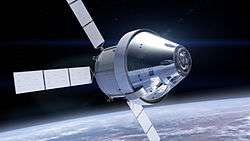
In May 2011 the ESA director general announced a possible collaboration with NASA to work on a successor to the ATV.[47] Later that year, a proposal to utilise an ATV derived service module for NASA's Orion capsule was revealed.[48] This service module would be provided as barter for the ESA's 8% share of the operating expense of the ISS, which had been fulfilled up to 2017 by the five ATVs. Developing a service module for Orion would cover the ESA's share of ISS operation up to 2020.[49]
"ESA’s contribution is going to be critical to the success of Orion’s 2017 mission"
—NASA Orion Program manager[10]
In June 2012, the ESA awarded two separate studies to Airbus, each worth €6.5 million, to evaluate options for using technology and experience gained from ATV and Columbus related work to cover the ESA's share of ISS operation past 2017.[50] One study looked into developing a service module for Orion, while the other examined development of a multipurpose vehicle that could resupply space stations, remove debris, and service satellites in orbit. The studies were to be completed before the end of 2012[51]
At the meeting of the ESA Ministerial Council in November 2012, the ESA committed to developing the service module,[52] and in mid-December signed an agreement with NASA to provide an ATV derived Orion Service Module for the first launch of Orion on the Space Launch System.[10]
The ESA awarded Airbus Defence and Space a €390 million ($488 million) contract in November 2014 to develop and build the module.[53]
ATV evolution proposals
Following the decision by NASA to retire the Space Shuttle in 2011, the European Space Agency launched a series of studies to determine the potential for evolutions and adaptations of the ATV. Following these studies the cargo return version (CARV) became a candidate for further development. The goal of this variant is to provide ESA with the capability to transport scientific data and cargo from the ISS to Earth. Beyond this, CARV could be enhanced to become a crew vehicle which would be launched by an adapted Ariane 5.
- Mini Space Station
- The MSS concept is an ATV evolution proposal for the construction of multiple ATVs with two docking ports, one at each end. The current version of the ATV is already prepared for a docking port at the back, with the main propulsion system arranged in a cylindrical fashion leaving room for a tunnel through the middle. This concept would allow Soyuz, Progress and other ATVs to dock to the back of the ATV, allowing a steady flow of Russian vehicles using the available docking ports whilst an ATV is docked for an average of around 6 months at a time.
- Payload Retrieval System
- The PARES would have included a small ballistic capsule similar to VBK-Raduga embedded into the ATV docking interface, which would have brought back a few tens of kilograms of payload. PARES could have featured a deployable heat shield system. The European Space Agency was also proposing the system for use with the Progress spacecraft and the H-II Transfer Vehicle (HTV).
- Cargo Ascent and Return Vehicle
- The CARV would deliver a redesigned capsule, capable of bringing back payload from orbit. It could be installed in place of the ATV pressurized cargo hold. In addition, it could be adapted to dock at the US side of the station. Given the larger docking ports there, it would be possible to transfer complete International Standard Payload Racks (ISPRs) from the ATV to the station, which is not currently possible.
- Crew Transport Vehicle
- This is another option under consideration. Similar to the CARV variant, this would replace the current Integrated Cargo Carrier with a pressurized re-entry capsule. A significant difference with the cargo-only variant would be the presence of a Crew Escape System, consisting of a number of booster rockets able to pull the crew capsule away from the launcher (Ariane 5) and/or Service Module in the event of an emergency. The CTV variant of the ATV could be able to seat 4 or 5 crew members.[54]
Possibilities for launching of the ATV on other launchers than the Ariane 5 have also been investigated, in particular in the frame of Commercial Orbital Transportation Services. ESA and its member states will consider approval for further ATV development in the coming years.
-

An MSS could be used as a small orbital lab
-
PARES capsules would be able to hold a few kg of cargo
-
CARV would be used to transport a large amount of cargo to Earth
Proposed crewed version
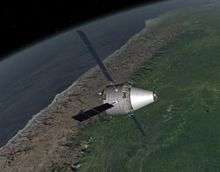
The aerospace company EADS Astrium and the German Space Agency (the DLR), announced on 14 May 2008 that they would pursue a project to adapt the ATV into a crew transportation system.[55] The craft would be able to launch a 3-person crew beyond LEO via use of a modified version of the Ariane 5 rocket and would be more spacious than the Russian Soyuz. A mock-up of the proposed craft was shown at the 2008 International Aerospace Exhibition in Berlin.[56] If the project is given ESA approval development will proceed in two stages:[57]
- The first stage would see the development of an Advanced Reentry Vehicle (ARV)[58] capable of transporting up to 1,500 kg of cargo from space to earth safely (see CARV above) by 2015.[59] This capability would be available to ESA even if further development were to be halted. It would prove useful in the ISS program as well as the proposed Mars Sample Return Mission with NASA. ARV development would make use of work done on the Atmospheric Reentry Demonstrator, Crew Return Vehicle and related projects. The budget for this stage of the ATV overhaul would reportedly be €300 million.[60][61][62]
- The second stage would adapt the then existing capsule to be able to transport people safely as well as upgrade the propulsion and other systems in the service module and would last 4 to 5 years at a cost of "a couple of billion [euro]" according to a senior Astrium representative.[56][63][64]
In November 2008, ESA ministers budgeted for a feasibility study into developing a re-entry capsule for the ATV, a requirement for developing either a cargo return capacity or a crew version of the ATV.[65] ESA signed a €21 million study contract with EADS Astrium on 7 July 2009.[66][67] The ARV effort was discontinued after the B1 stage due to fiscal constraints resulting from the Late-2000s financial crisis.[68]
See also
- Comparison of space station cargo vehicles
- Commercial Orbital Transportation Services – NASA initiative to create a commercial cargo and crew transportation capability to and from the ISS.
- CSTS
- Automated cargo spacecraft – other ISS resupply vehicles:
- Cygnus spacecraft – developed by Orbital Sciences Corporation.
- Dragon Cargo spacecraft – only vehicle capable of returning cargo to Earth,[69] developed by SpaceX.
- H-II Transfer Vehicle – developed by Japan Aerospace Exploration Agency.
- Progress spacecraft – developed by Russian Federal Space Agency.
- Excalibur Almaz, which plans for their capsule to use a service module based on the ATV design, according to Art Dula, the chairman of Excalibur Almaz.[70]
References
- ↑ "Final preparations for first human-rated spacecraft to be launched from Europe's Spaceport – ESA". Esa.int. 18 December 2007. Retrieved 2011-03-01.
- 1 2 "ATV configuration". Esa.int. 9 March 2010. Retrieved 2011-03-01.
- 1 2 "Automated Transfer Vehicle (ATV) Utilisation Relevant Data Rev. 1.2" (PDF). ESA ERASMUS User Centre.
- ↑ "ESA – ATV Integrated Cargo Carrier". Esa.int. 9 March 2010. Retrieved 2011-03-01.
- ↑ "Automated Transfer Vehicle, ESA document EUC-ESA-FSH-003 Rev 1.2 (specification)" (PDF). ESA. Archived (PDF) from the original on 22 March 2007. Retrieved 2007-03-26.
- 1 2 "Breaking News | ATV production terminated as decision on follow-on nears". Spaceflight Now. 2012-04-02. Retrieved 2012-09-04.
- ↑ "Berlin unveils 'crewed spaceship'". BBC.com. 28 May 2008.
- ↑ "ATV evolution: Advanced Reentry Vehicle (ARV)". ESA.int. 25 March 2010.
- ↑ "Europe to explore the future of the ATV". Sen.com. 2012-06-23. Retrieved 2012-09-04.
- 1 2 3 NASA Signs Agreement for a European-Provided Orion Service Module
- ↑ "Rendezvouz and Docking Technology" (PDF). ESA. February 2008.
- ↑ Power system and avionics, ESA, 3 March 2008, "The ATV Service Module also accommodates several rechargeable and non-rechargeable batteries and some redundant items like a Sun sensor and a Russian-made KURS antenna."
- ↑ Bryan Burrough, Dragonfly, ISBN 0-06-093269-4, page 66, "made by a government-owned company called Radiopribor, located in Kiev"
- ↑ "ATV arrives at Europe's Spaceport". European Space Agency. 1 August 2007. Archived from the original on 8 August 2007. Retrieved 2007-08-03.
- ↑ "Worldwide Testing And ISS Traffic Push ATV Launch To Autumn 2007". SpaceDaily. 23 March 2007.
- ↑ "Alenia Spazio signs contract with RSC-Energia for the production phase of the ATV space vehicle" (Press release). Alenia Spazio. 22 March 2005. Retrieved 2009-03-21.
- ↑ "Europe sets a course for the ISS". German Aerospace Cente. 25 February 2008. Retrieved 17 August 2011.
- ↑ Stephen Clark (1 December 2009). "Space station partners assess logistics needs beyond 2015". Spaceflight Now. Archived from the original on 4 December 2009. Retrieved 1 December 2009.
- ↑ "Mission concept and the role of ATV". ESA. 3 March 2008. Archived from the original on 12 March 2008. Retrieved 2008-03-24.
- ↑ "Multi-Program Integrated Milestones" (PDF). NASA. 25 January 2008. Retrieved 20 May 2013.
- ↑ "European Cargo Ship Begins Maiden Space Voyage". Space.com. 9 March 2008. Retrieved 20 May 2013.
- ↑ "Europe's second cargo freighter to fly in December". Spaceflight Now. 17 September 2010. Retrieved 18 September 2010.
- ↑ "One-day delay of final shuttle launch makes room for ATV". Spaceflight Now. 1 October 2010. Retrieved 2 October 2010.
- ↑ "Third ATV named after Edoardo Amaldi". ESA. 17 March 2010. Retrieved 17 March 2010.
- ↑ "Europe's third cargo vehicle docks with the Space Station". ESA – ATV. 29 March 2012. Retrieved 31 March 2012.
- ↑ "Deorbit burns set for Tuesday night/Wednesday morning". ESA ATV blog. Retrieved 2 October 2012.
- ↑ "Mission accomplished for ATV Edoardo Amaldi". Space-Travel.com. 4 October 2012. Retrieved 8 October 2012.
- ↑ "ATV-4 scheduled for summer liftoff". ESA. 11 April 2013. Retrieved 14 April 2013.
- ↑ "Mission brochure – ATV Albert Einstein". ESA. 14 April 2013. Retrieved 12 June 2013.
- ↑ "Europe's largest spaceship reaches its orbital port". ESA. 15 June 2013. Retrieved 15 June 2013.
- ↑ "A fiery end to a perfect mission: ATV Albert Einstein". ESA. 2 November 2013. Retrieved 3 November 2013.
- ↑ http://blogs.esa.int/atv/2014/07/22/arianespace-flight-va219-ariane-5-es-atv-5-launch-scheduled-for-tuesday-july-29/
- ↑ http://www.esa.int/Our_Activities/Human_Spaceflight/ATV/Last_ATV_reentry_leaves_legacy_for_future_space_exploration
- ↑ "Europe's 'Jules Verne' spacecraft carries namesake's notes on maiden voyage". collectSPACE.com. 7 March 2008. Archived from the original on 10 March 2008. Retrieved 2008-03-07.
- ↑ Stephen Clark (17 February 2011). "Europe dispatches Johannes Kepler to space station". Spaceflight Now. Retrieved 20 March 2011.
- ↑ "Europe's ATV space ferry ready for launch". ESA. 3 February 2011. Retrieved 3 February 2011.
- ↑ Chris Gebhardt (15 February 2011). "Ariane 5 launches ATV-2 for journey to the ISS". NASAspaceflight.com. Retrieved 2011-03-20.
- ↑ "ATV 'Johannes Kepler' Launch to Space Station Delayed to Wednesday". Universetoday.com. 2011-02-15. Retrieved 2012-09-04.
- ↑ "ATV rotates the ISS for Progress docking". 29 April 2011. Retrieved 3 May 2011.
- ↑ "ATV undocking set for 20 June". 15 April 2011. Retrieved 3 May 2011.
- ↑ Gutierrez-Marques, Pablo. "Express mail to low earth orbit". The Planetary Society. Retrieved 6 September 2011.
- ↑ "Europe's heaviest cargo ship launched to Space Station". ESA. 5 June 2013. Retrieved 6 June 2013.
- ↑ "Europe's largest spaceship reaches its orbital port". ESA. 14 June 2013. Retrieved 14 June 2013.
- ↑ "ATV completes final automated docking". ESA. Retrieved 1 September 2014.
- ↑ "Airbus Defence and Space prepares launch of ATV-5 "Georges Lemaître"". Airbus Defence and Space. Archived from the original on 19 September 2014. Retrieved 1 September 2014.
- ↑ "ATV Control Centre". European Space Agency. Archived from the original on 17 March 2008. Retrieved 2008-04-03.
- ↑ "US and Europe plan new spaceship". BBC News. 5 May 2011. Archived from the original on 6 May 2011. Retrieved 2011-05-14.
- ↑ "European tech could propel Nasa's Orion capsule". BBC News. 20 September 2011. Retrieved 2011-09-20.
- ↑ "Europe seeks greater role in NASA's exploration missions". Spaceflight Now. 26 June 2011. Retrieved 2011-06-26.
- ↑ "Astrium awarded two ATV evolution studies from ESA". Astrium. 21 June 2012. Retrieved 2012-06-23.
- ↑ "ATV evolution studies look at exploration, debris removal". Spaceflight Now. 21 June 2012. Retrieved 2012-06-23.
- ↑ "UK steps up, as ESA commit to ATV Service Module on NASA's Orion". NASASpaceFlight.com. 2012-11-21. Retrieved 2015-03-08.
- ↑ "Airbus wins contract for US space capsule Orion". Reuters. 18 November 2014. Retrieved 2014-11-18.
- ↑ "ATV Evolution — Executive Summary" (PDF). EADS. Retrieved 2008-03-15.
- ↑ "Europe could get manned spaceship". BBC News. 13 May 2008. Retrieved 1 January 2010.
- 1 2 "Berlin unveils 'crewed spaceship'". BBC News. 28 May 2008. Retrieved 1 January 2010.
- ↑ "Celebrating the Accomplishment, Preparing the Future — New Challenges in Human Spaceflight and Exploration '" (PDF). ESA.
- ↑ "End-to-end European transportation capability: The Advanced Reentry Vehicle". ESA. Retrieved 2015-03-08.
- ↑ ""Jules Verne" Automated Transfer Vehicle (ATV) Information Kit" (PDF). ESA. Retrieved 2015-03-08.
- ↑ "Europe Plans to Build Manned Spaceship". Der Spiegel. Retrieved 2015-03-08.
- ↑ "European manned spaceship design unveiled in Berlin". The Register.
- ↑ "ESA aims for manned capsule by 2020". Flightglobal. Retrieved 2015-03-08.
- ↑ "Europe Plans Manned Spaceship". businessweek.
- ↑ "Europe Aims For Re-entry Spacecraft". Space.com. Retrieved 2015-03-08.
- ↑ "Europe's 10bn-euro space vision". BBC News. 26 November 2008. Retrieved 31 March 2010.
- ↑ http://www.astrium.eads.net/en/press-releases-launch-kits/atv-johannes-kepler-put-through-its-paces.html. Retrieved 15 January 2010. Missing or empty
|title=(help) - ↑ "ESA – Human Spaceflight and Exploration – Advanced Reentry Vehicle activities begin with contract signature". Esa.int. 7 July 2009. Retrieved 2011-03-01.
- ↑ "The Space Truck". euronews. 18 May 2011. Archived from the original on 5 June 2011. Retrieved 20 May 2011.
- ↑ Dragonlab datasheet, v.2.1 Archived 4 January 2011 at the Wayback Machine., 2009-09-18. Retrieved 2011-01-02.
- ↑ "Interview with Art Dula (Chairman Excalibur Almaz) - Part 2". moonandback.com (vimeo.com). Retrieved 4 September 2012.
External links
| Wikimedia Commons has media related to Automated Transfer Vehicle. |

